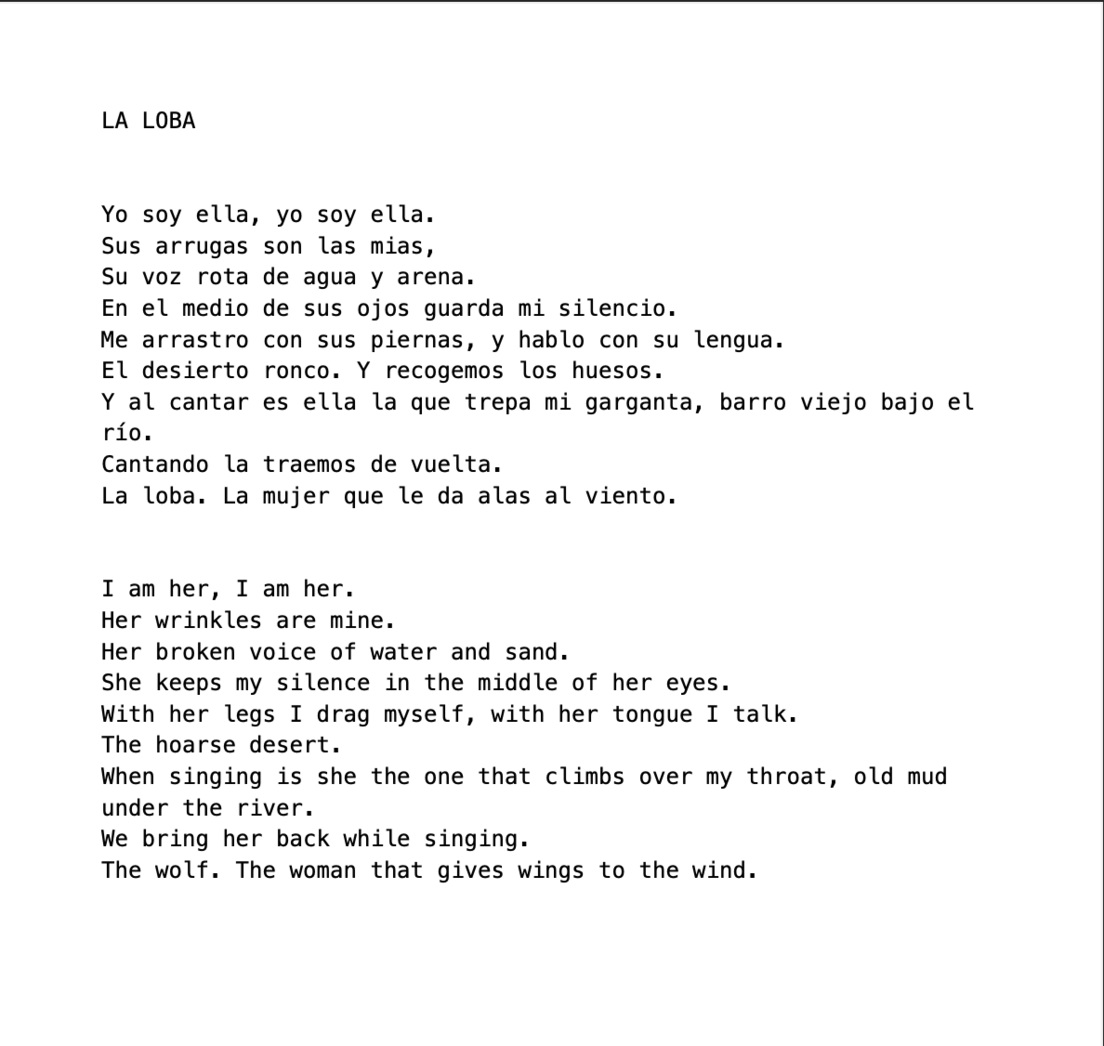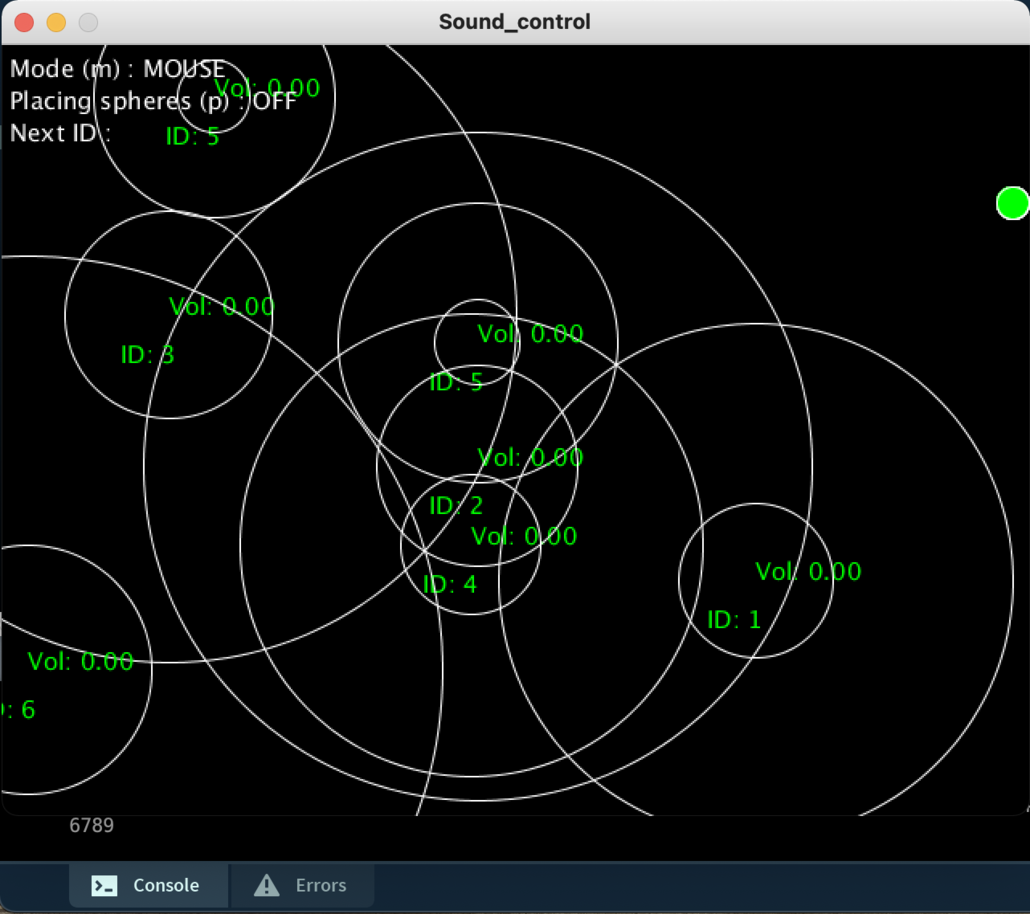The angularity and tension come in the form of tritones in the wind's cell, and the sharpness of the voice intervals. Adding to that, the voice lines are not always a part of the harmonic landscape of the other instruments, enhancing the dissonance.
This cell that starts as a pattern finally disintegrates in a chaotic texture and blending of the lines of the different instruments, marking the entrance of the electronics, which are also built following the idea of various timbrical layers. The electronics serve here as a transition between two distinct worlds, between chaos and order, tension and rest.
They maintain the layers of the instruments, as an extension of them, as a transformation of their sound. This is actually the case since most of the material in the electronics here comes from recordings of the piano and string instruments.
At first, the live manipulation of the sounds in the electronics was made with a midi controller. But then I came across the possibility of using the Kinect camera for movement tracking and the image expanded.
The use of the camera allows the transition to be not only metaphorical or conceptual but to be also represented in the space. There is an actual movement from one place to the next, from one sounding idea to the next one. Through the motion of my body, I tried to express the emotional change that lies between the stories, traveling the space that separates them.
LA LOBA
La Loba (The wolf woman) was the first attempt I did at using stories as the main or only source of material for composing. Some tales have stayed with me throughout the years. Either because they had a special emotional impact in the moment of reading, or because they generated very vivid images and colors. So to start with one of those seemed a natural continuation of an idea that had been unnoticeably lurking in my head for years. La Loba is an old Mexican story that I discovered while reading Women who run with the wolves, by Clarissa Pinkola Estés. It’s about an old woman, as old as time is, that lives in the desert. Her only mission is to recollect bones from different creatures. She especially likes the ones from wolves. Once she has gathered a whole skeleton, she sits by the fire and thinks about a song to sing to it. When she sings, the flesh grows back into the bones, the creature starts breathing again, and then it rises and goes running away.
The approach that I took to the story was mainly intuitive. I read the story, then sit on the piano and tried to convey the image into sounds. First I started with the motif that afterward would go into the winds, and then I used that as the grounding for building the melody. I had the poem and sang the words as close as possible as if they were spoken, going with the idea of storytelling.
For me, the story was connected to warm colors, transformation, and angularity, and it had a feeling of tension. The focus point was the voice, working as the driving force and as an independent layer. It has a character of its own, some sort of impersonation through the words navigating across the other instruments. The motif of the winds is connected to the idea of something that evolves, a circular pattern that gets broken and transforms into something else. I decided, in this particular case, that I would leave that change open to the players. So coming from the idea of these three notes that create a pattern, they would have the freedom to escape and break out of it.
EYALIRTAQ
This is a story that comes from the North, with versions in Siberia, Iceland, and the northwest of America. It comes from the same book as the previous story, and I decided that they could work well together. They both talk bout the magic and intuitive processes that come from the underworld, from the depths of our psyche, those that can only be accessed in particular moments, or through concrete rituals. They both use animals, the wolf, or the seal in this other one, to symbolize the wilderness that still lies inside of us, our instincts, all that cannot be grasped or understood; what lies under the surface.
In this story, a seal-woman loses her sealskin, which is stolen by a fisherman. The fisherman tells her that if she wants it back she has to marry him and stay seven years on the surface, and then if she still wants to go back, he will tell her the place where he is keeping her sealskin. Without the sealskin, she can’t go back to the sea, so she accepts, staying far away from home and her magical powers. Seven years pass and the fisherman refuses to give her the sealskin. She is slowly dying because she’s not meant to be outside of the water for such a long time. Finally, she hears a voice that guides her to the sealskin and she can go back to the sea.
While reading the tale I had a very clear picture of white plains, vast and deserted. An immense white steppe where nothing grows, that extends till the horizon. It came also with a sense of stillness, silence; absence. I wanted it to sound transparent, scattered, like a layer of air.
In contrast to La Loba, almost everything is written here, because I found it very hard to achieve such a minimal, almost never-changing arc of sound through improvisation since space tends always to be filled.
With this idea of something that extends as far as the eye can see, something infinite, circular, I thought of three distinctive layers, separated by timbre. The first one is built with the piano and the strings (violin and double bass) and uses mainly 5ths and 4ths. This creates an open transparent sound, and works as a circular structure, since it repeats the same notes over and over, with small variations. The winds have the “leading” role here; each one of their phrases works as a trigger for the rest to restart the movement. They also stand out because their harmony is outside of the very stable chords of the piano and the strings, so there is a clash where they are meeting each other. The voice is part of the landscape and works as a connection between air and bows. There are no words, just an arc of breath moving in and out. Between each of the phrases, there’s a moment of silence, of stillness, a pause.
Each one of the layers is fixed in itself, they are static and insistent in their shapes.
There were several challenges while composing these two pieces. The main one was trying out the idea of circularity. I usually compose by searching for harmonic development or conceiving the harmonic shifts as a way of structuring the form of a piece. And in this case, I wanted to explore the opposite; having a very limited movement in the harmonies, and specifically a movement that repeats itself. Which made me look for other ways of developing time and material. In La Loba I ended up following a process of deconstruction; something very clearly established dissolves. And in Eyalirtaq the repetition remains unaltered; there’s no evolution.
The other big challenge was to add movement. This was also the first time I have considered including movement as a part of the music. So there was a big question regarding body language; how should I move? And why? How do I connect with this music physically? The fact that it is not only movement but a movement that is creating a sound, a specific sound, has a big weight. When dancing, there is a reaction to the music, it starts with listening and from there it goes into the action. But here it is the other way around, the way I move is going to generate a sound, and depending on the movement, that sound is going to change. With these questions, I started an exploration of how to connect my own body to music.


